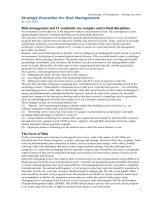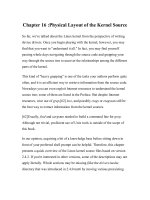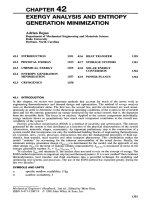Tài liệu Decision Analysis and Risk Management: Two Sides of the Same Coin pdf
Bạn đang xem bản rút gọn của tài liệu. Xem và tải ngay bản đầy đủ của tài liệu tại đây (125.77 KB, 9 trang )
Decision Analysis and
Risk Management:
Two Sides of the
Same Coin
1-800-COURSES
www.globalknowledge.com
Expert Reference Series of White Papers
Introduction
Every decision involves an analysis of possible future events (costs, outcomes, markets, etc.) and selection of a
choice among competing alternatives. Making a decision is making a selection.
Decision analysis is the process of dismantling a decision so as to determine the inputs and processes that
went into arriving at a decision.
Risk management is managing (preparing for) future uncertainties. Uncertainties are risks. They are the
unknowns associated with future events
.
The decisions we make today create the risks that we must manage tomorrow.
Risk management and decision analysis are effectively the same thing. They both involve the dismantling of
choices so as to understand the uncertainty of outcomes associated with particular options that have been, or
could be, made.
It follows that high quality decision making serves the purpose of risk management. If our decisions include a
thorough consideration of uncertainties
, then future risks are simplified or minimized.
But what is a high quality decision? How do we judge decision quality?
This white paper provides an outline of how to judge the quality of decisions by analyzing how effectively the
risks associated with various options have been analyzed. We begin with a definition for quality control in
decision making. This definition is then related to the four steps of the decision making process and finally to
the three types of error (risk) that occur in each of the four steps.
The paper concludes with an example of how methodical decision analysis leads to an understanding of the
degree of risk in a decision.
Defining Quality
Every decision is a balance between what we believe to be true and what we are forced to predict. Every deci-
sion involves the analysis of available information and ultimately the selection of a choice among alternatives
with varying degrees of uncertainty.
Brian Denis Egan, Global Knowledge Instructor, MBA, PMP
Decision Analysis and Risk Management:
Two Sides of the Same Coin
Copyright ©2005 Global Knowledge Network, Inc. All rights reserved.
Page 2
I
t follows that the better our information and the more balanced and thorough the analysis, the higher can be
the quality of our decisions. Better decisions are informed, reasoned, and balanced. Making better decisions
means living with less risk.
Poor decisions are risky. They are made without a full understanding of what might go wrong. It is not that if
you make a poor decision you are necessarily going to be proven wrong (e.g. make a bad investment or pur-
chase a defect-prone vehicle), but that the decision was made without a full understanding of the uncertain-
ties or risks involved.
With poor decisions, risks are understated and returns exaggerated. High quality decisions imply a complete
understanding of the uncertainties involved. Making high quality decisions involves recognizing what risks you
are taking. It is about making informed decisions.
Risks are the residual uncertainties left behind when decisions are made without perfect information. But of
course we never have perfect information. We therefore make decisions based on what we believe to be true
and tak
e a chance (accept the risks) of being wrong. High quality decisions are decisions in which the magni-
tude of the risk of being wrong is understood.
The quality of decisions can therefore be judged by the degree to which uncertainties (risks) are considered in
the decision making process. The highest quality decisions are the ones that have the least unknowns. In other
words, they are made with the most knowledge about possible future events.
Risk management (planning for possible future events) therefore begins by ensuring that an organization’s
decisions are of the highest possible quality given the constraints of time and resources.
Quality Decisions and Risk Management
The quality of an organization’s risk management is the degree to which we understand the uncertainties
(risks, implications) of future events. The quality of one’s decision making is measured according to how well
uncertainties have been considered.
Quality controlling decisions are based on analysis of risk. The thoroughness of the analysis determines the
“quality” of the decisions.
High quality decisions are not the best decisions in hindsight. They are the best decisions in foresight.
A high quality decision may not prove to be the optimum choice that could have been made. Instead, it is the
best decision that could have been made given the resources and information av
ailable at the time of the decision.
Decision Process
To fully understand the risks associated with a decision, and therefore to manage risks most effectively, it is
necessary to understand the four steps (broadly speaking) involved in making a decision.
1. Identify a problem
2.
Identify options or choices
3.
Comparative analysis
4. Make a decision or choice
Copyright ©2005 Global Knowledge Network, Inc. All rights reserved.
Page 3
W
hen we speak of identifying a problem we mean recognition and interpretation of the problem. Your car is
dying of old age and you need to get to work every day. The problem might therefore be identified as “what to
do in terms of replacing the car”, or “how will I get to work if the car dies tomorrow”?
How one perceives the problem under consideration ultimately determines how the problem is analyzed in the
decision-making steps that follow. Do you need a new car or do you need inexpensive, flexible transportation
to work? How you frame the “problem” affects what choices are identified as possible solutions and how the
choices are ultimately compared.
Step 2 is the identification of options from which the selection will ultimately be made. The breadth and depth
of choices is determined by both the way the problem has been framed and the creative effort put into gener-
ating alternative choices.
If the problem is thought of as “inexpensive transport to work” rather than “I need a new car”, then anything
from bicycles to roller blades are possible solutions, and not just the options of a new or used car.
Step 3 is comparing the alternatives that have been identified in step 2. This involves a comparison of the pros
and cons, costs and benefits of each alternative based on criteria, and standards established by the person
doing the analysis
. Roller blades are less expensive than a car
, but a lot more work and slower.
Step 4 is making a decision. Whether roller blades are the best decision depends on the decisions maker’s pref-
erences, distance to work,
and physical abilities.
There is never (or very rarely) one obvious or “correct” choice on which a variety of different decision makers
would unanimously agree
. Instead, a preferred choice reflects the decision maker’s interpretation of the avail-
able information and their unique sense of risk and return.
Risk in the Decision-Making Process
Analyzing risk requires an understanding of the types of uncertainty that can be incorporated into a decision.
There are three sources of uncertainty inherent in decision making.
• Known unknowns
• Unknown unknowns
• Analytical bias
Known unknowns are areas of uncertainty that are recognized and integrated into the decision-making
process
.
T
his is the stuff about which we know we should be concerned.
In the example of choosing which type of new car to purchase, the known unknowns include future repair
costs (after the w
arranty period is over) for one brand versus another
, or residual value (sale price) after a
number of years of use. These are issues that we know to worry about but do not know just how worried to
be.
Unknown unknowns are risks (uncertainties) that are relevant to the decision but that are not included in the
analysis. This is the stuff that is ”off our radar”.
Copyright ©2005 Global Knowledge Network, Inc. All rights reserved.
Page 4
W
hen choosing a new car the unknown unknowns are possible events like: the car manufacturer going bank-
rupt which voids the service warranty; repair parts being unavailable when needed; or the car being under-
insured in the event of a major accident.
Unknown unknowns are those possible events that you just would not normally think of in advance but could
crop up to cause problems.
Unknown unknowns are determined by your level of knowledge about a particular situation. The more
informed you are the fewer (or more obscure) the unknown unknowns.
For example, a lawyer can enter a courtroom with a full understanding of what to expect when defending a
client. They may be surprised by some events but the likelihood of surprise declines with a lawyer’s increasing
experience and knowledge base.
On the other hand, a layman who enters a court, preparing to defend himself, is likely to encounter many
unknown unknowns
. These are issues the layman was unaware needed to concern him. The more research and
education the layman undertakes before entering court, the fewer surprises there are likely to be.
Unknown unknowns are therefore the issues that increasing degrees of expertise will reveal.
The less you
know, the more unknown unknowns there are—that is, the fewer known unknowns that you know.
The third element of risk,
analytical bias
, relates to imperfections in our understanding and analysis of choices.
This is the stuff of habit, prejudice, and mental laziness.
Analytical bias may be referred to as the unknown unknowns of the known unknowns
. (Whew!) It is a conse-
quence of being human. Every analysis is a reflection (to some degree) of the person doing the analysis.
Analytical bias is the difference between what we believe to be true and what is actually true. It is the differ-
ence between fact and perception.
Critical thinking is the tool that is used to reveal bias. It involves deconstructing the way someone is thinking
into the elements or processes involved in the reasoning process. Through critical thinking it is possible to
develop a thorough understanding of what inputs (biased or otherwise) have gone into the reasoning process.
For a brief introduction to critical thinking, see the white paper,
The Role of Critical Thinking in Effective
Decision Making
,
at www
.globalknowledge
.com/resourcecenter
.
Risk in Decision Making
For the purpose of discussion, let’s assume you have decided to buy a new car and have selected a particular
make and model. What are the risks associated with this decision?
Broadly speaking, the risks inherent in a decision relate to the four steps in the decision making process.
1.
Identification and interpretation of the problem.
a. Known unknowns – Have I defined my transport needs correctly?
b. Unknown unknowns - Should I be considering alternative transport options?
c. Analytical bias - Would someone else interpret the situation differently?
Copyright ©2005 Global Knowledge Network, Inc. All rights reserved.
Page 5









